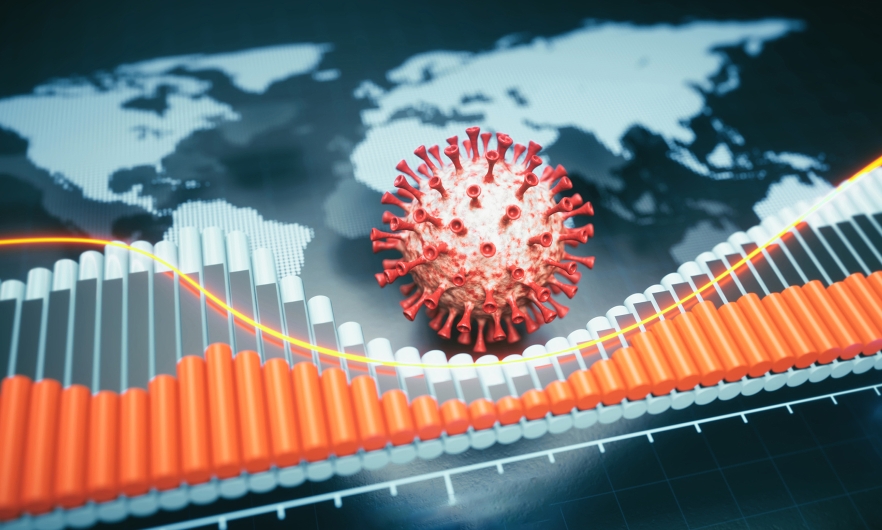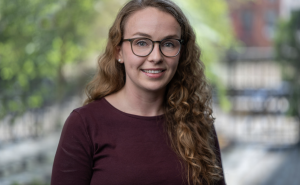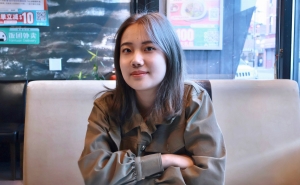What Does the Future of COVID-19 Look Like?

Is it possible to know what the next six months will look like when it comes to COVID-19? Thanks to a Modeling Hub developed by nine research teams across the country—and here at Johns Hopkins—we have an idea. Researchers have projected what could happen under four scenarios of vaccination rates, including authorizing vaccines for children, and the possibility for new variants.
In this Q&A adapted from the October 1 episode of Public Health On Call, infectious disease epidemiologist Shaun Truelove, PhD ’17, MPH, talks with Joshua Sharfstein, MD, about the COVID-19 Scenario Modeling Hub’s models for the next six months into early 2022.
WHERE ARE THESE NINE TEAMS FROM?
The Johns Hopkins Infectious Disease Dynamics group is one of the teams—we produce our own model. The Johns Hopkins Applied Physics Lab has a model. There's a model from Northeastern University, one from the University of Southern California, two models from the University of Virginia, one from the University of North Carolina, and one from Columbia University.
HOW DOES THE MODELING HUB WORK?
We give the teams a set of scenarios with some assumptions, and then they produce a set of projections for those scenarios of what might happen.
Each of these models assumes different things, they offer different scientific expertise, different structures. [We] bring all of that together, and look at what could potentially happen.
LET'S TALK ABOUT THE SCENARIOS. YOU GO OUT TO THESE NINE TEAMS AND SAY, ‘WE WANT TO SEE YOUR PROJECTIONS UNDER THESE FOUR DIFFERENT SETS OF CONDITIONS.’ WHAT'S THE FIRST ONE?
The first scenario, which would start on November 1, looks at what might happen if child vaccinations start for children 5 to 11 years old. In this scenario, there wouldn’t be any new variants—we would only be dealing with delta—and there wouldn’t be any transmission change because of the virus changing. That’s our optimistic scenario.
The next scenario is assuming that there are still no new variants, but that child vaccination for some reason doesn't get approved. In the third and fourth scenarios, we incorporate a new variant. This is assuming that there's a new variant that comes in mid-November that is 50% more transmissible than delta.
Before we get to the results, how do you handle the fact that there are so many different levels of vaccination across the United States? Do you assume that the vaccination of adults is frozen? Or does this make any other assumptions about what's going to happen in different parts of the country?
Each team is doing its own thing with this, but from the coordinating level, we’re trying to encourage certain assumptions. One of those assumptions is trying to predict not just the pandemic and transmission, but what's going to happen in some of these important inputs—vaccination is one of them. We're basing what might happen with vaccination on surveys about vaccine hesitancy and vaccination saturation coverage across the U.S. Teams are taking into account the state-specific estimates from these surveys and incorporating that into their models and their projections.
Is it the same story for boosters? Are there assumptions about boosters?
Some teams are making assumptions about boosters; some are not. The same thing for vaccine effectiveness—each team is making their own best guess based on their research on vaccine effectiveness.
Under scenario A, which is the best-case scenario—where we have childhood vaccination by November and there is no new variant—what do these models predict?
In this scenario, we think that we are close to or at the peak of deaths and that we're going to see continuous declines in the number of deaths per day. These are six-month projections, and we think by the end of those six months and mid-March, we'll be seeing about 60 deaths a day as opposed to 2,000.
What about the second scenario, where there is no childhood vaccination and also no variant?
We see similar things happen. But in that scenario, there are slightly more deaths. I think we're estimating about 120 deaths, so about double the deaths. Those are still very low numbers, and that's really because we think vaccination is very widespread, especially among the individuals who are most at risk for death. We also think transmission is declining, in large part because of the broad immunity in the population.
Not every one of these models have exactly the same number of deaths predicted. What was the range of the different estimates that the groups came up with?
There's quite a bit of variability. The median estimate is somewhere around 60, but it's as low as zero deaths per day and goes all the way up to 500. There's high confidence that there are substantially fewer deaths, in comparison to now, occurring at that time. We think we save about 9% of deaths with childhood vaccination.
The last two scenarios assume a variant that is 50% more transmissible than delta. What happens if we have childhood vaccination, and a more dangerous or at least more transmissible variant?
With childhood vaccination and this new theoretical variant, we do see that there is the potential for cases to start increasing again, starting probably in early 2022 and increasing through the end of our projections. The increase is relatively slow, but we’re not able to see where this might peak because we can’t see the end of the projections.
What’s the ensemble prediction for approximate deaths in six months?
We think it’s probably about 400 deaths per day.
What about the last model—the worst-case scenario of no childhood vaccination and a new variant?
That’s where we see the most potential resurgence and potential impact among all these scenarios. We still see similar declines starting now through the end of the year, but then that resurgence is a bit higher than we see if there is childhood vaccination. We think deaths compared to [what we would see if we have] childhood vaccination are around double what we would expect otherwise—maybe around 800 deaths per day. But of course, this is theoretical, where we are [allowing for] a new variant that doesn't necessarily exist or may never exist.
Childhood vaccination at the moment looks promising. If we can do that, and really work on our global vaccination efforts, so that we don't start to see worse variants, we could be in a much better place in 2022.
Shaun Truelove, PhD ’17, MPH, is an assistant scientist in International Health. Truelove’s work focuses on vaccination impact and understanding the potential for outbreaks in various settings.
Related:
- What Might the Next Six Months of COVID-19 Look Like in the U.S.? (podcast)
- Back to School: Vaccinating Kids and Teens
- COVID-19 and Vaccine Mandates





